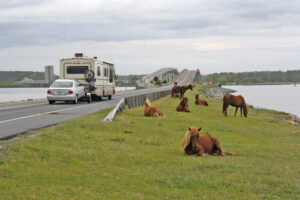
BERLIN – A recent report shows tourism to Assateague Island National Seashore contributed $116 million to the local economy in 2022.
On Tuesday, the National Park Service released a new report that shows 2.3 million visitors to Assateague Island National Seashore spent $116 million in communities near the park in 2022.
That spending, the agency reports, supported 1,410 jobs in the local area and had an economic output of $139 million in local economies surrounding the park.
“People come to Assateague Island National Seashore to camp, enjoy the beach and bay and view the wild horses,” said Superintendent Hugh Hawthorne. “We recognize that this tourism is a critical driver to the local economy, bringing 1,410 jobs and $139 million revenue to communities within 60 miles of the park.”
In recent years, Assateague Island National Seashore has reported an uptick in visitation largely fueled by the COVID-19 pandemic and a desire to take advantage of outdoor recreation.
In 2021, for example, the park received a record 2,662,716 visitors to its Maryland and Virginia units, placing Assateague Island 33rd among all national parks reporting visitation numbers. It also led to record-breaking visitor spending, with $131 million contributed to the local economy that year.
According to National Park Service data, 2022 marks the second year since 2012 that Assateague Island National Seashore reported a decline in visitor spending from the prior year. In 2018, for example, spending decreased by $5 million. And in 2022, spending dipped $15 million.
The National Park Service also tracked sectors directly affected by visitor spending. Last year, $31.4 million was spent on local lodging, $26 million was spent at local restaurants, $20.6 million was spent on gas and $16.6 million was spent on groceries. Visitors to Assateague Island National Seashore also spent $8.4 million on retail, $7.6 million on recreational industries, $4.1 million on camping and $1.8 million on transportation.
“Since 1916, the National Park Service has been entrusted with the care of our national parks,” said National Park Service Director Chuck Sams. “With the help of volunteers and partners, we safeguard these special places and share their stories with more than 300 million visitors every year. The impact of tourism to national parks is undeniable: bringing jobs and revenue to communities in every state in the country and making national parks an essential driver to the national economy.”
The peer-reviewed visitor spending analysis was conducted by economists at the National Park Service.
The recent report recorded $23.9 billion in direct spending by nearly 312 million park visitors in communities within 60 miles of a national park in 2022.
This spending, the agency reports, supported 378,400 jobs nationally, 314,600 of which are found in these gateway communities. The cumulative benefit to the U.S. economy was $50.3 billion.
As for the economics of visitor spending, the lodging sector had the highest direct effects, with $9 billion in economic output nationally. The restaurants sector had the second greatest effects, with $4.6 billion in economic output nationally.
Year-to-year trend data and additional information on visitor spending across all parks can be found on the National Park Service Social Science Program webpage at nps.gov.

